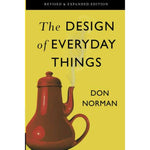- Home
- Educational
- The Design of Everyday Things
The Design of Everyday Things
Couldn't load pickup availability
Summary
The Design of Everyday Things by Don Norman is a groundbreaking book that explores the principles of good design and the psychological factors that influence human interaction with products. Norman argues that design should be user-centered, meaning products should be intuitive, easy to understand, and designed with the user’s needs in mind. The book provides insight into how well-designed objects can improve our daily lives, while poorly designed ones lead to frustration and confusion.
Norman introduces concepts like affordances (how an object suggests its use), feedback (how an object provides information about its actions), and constraints (limitations that help guide users), which are crucial to creating user-friendly designs. He also examines the importance of simplicity, visibility, and accessibility in product design, stressing that a good design is often invisible—allowing the user to focus on the task at hand rather than struggling with the device.
Through numerous real-world examples, Norman demonstrates how design can impact our behavior and experiences, from everyday objects like door handles and light switches to complex technologies like smartphones and websites. He argues that designers should focus on usability and understanding how people think and behave to create products that are both functional and easy to use.
Key Points from The Design of Everyday Things
-
User-Centered Design
Good design begins with the user. Norman emphasizes that designers must prioritize the needs, abilities, and limitations of users in every step of the design process. Understanding how people interact with products and what they need from them is essential for creating functional and effective designs. -
Affordances and Signifiers
Affordances refer to the properties of an object that suggest how it can be used (e.g., a button that invites pressing), while signifiers are signals or clues that communicate how to use an object. Norman highlights the importance of clear affordances and signifiers to make designs intuitive and easy to interact with. -
Feedback is Essential
Feedback is critical in design, as it lets users know that their actions have been acknowledged. Whether it’s a sound, a light, or a visual cue, feedback helps users feel in control and understand the consequences of their actions, enhancing the user experience. -
The Importance of Constraints
Constraints guide users toward correct actions by limiting what can be done. Norman explains that constraints—whether physical, cultural, or logical—help users avoid errors and make decisions easier, leading to a smoother, more intuitive experience. -
Simplicity and Visibility
Simple, clear designs are more effective because they don’t overwhelm the user. Norman advocates for the visibility of essential features and controls, ensuring that users can easily figure out how to operate a product without unnecessary complexity.






